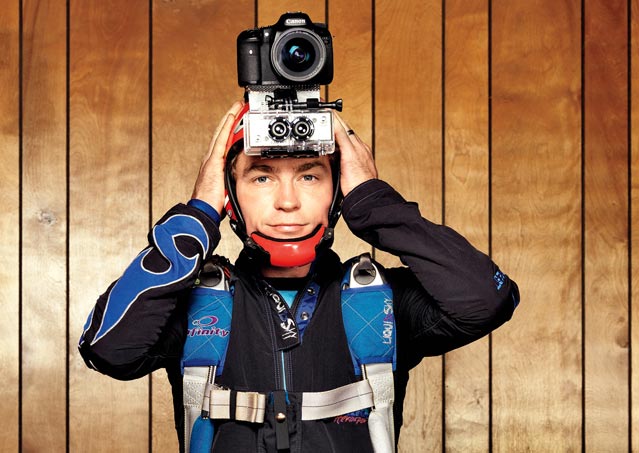I FELT LIKE I was under surveillance. It was a midwinter day at California’s ski resort, and as I shuffled into a lift line the cameras were mounted everywhere: on heads, on chests, atop that bearded guy’s ski pole. The boarder next to me on the quad chair had a camera fixed to his deck.
“I think that one drop is gonna look sweeeet,” he said to his buddy. “I can’t wait to watch it!”
That pretty much sums up the mantra of the new amateur action-sports auteur: it’s all about the footage. Pressing the record button has suddenly become a habitual part of our adventures—and not just at expected venues like Squallywood. “Honestly, there wasn’t any place I didn’t see a ton of cameras,” says professional big-mountain skier and BASE jumper , who last year competed and performed demonstrations across the United States, as well as in Europe and South Africa. “Everywhere I went, everyone, across all skill levels, was wearing them.”
By the end of last year, users of wearable sports cameras, the far-and-away leader in the category, were uploading clips to YouTube at a rate of one every three minutes. And people have been watching them. and you can sift through hundreds of amateur action videos—mountain biking, surfing, kiting, whitewater paddling, and on and on—with at least 10,000 views. This is because the footage is often really compelling. Whereas a camera phone spurs us to post Facebook videos of children and pets, a helmet cam makes us want to “Be a Hero,” as the GoPro tagline puts it.
This can be a problem. “Cameras push people to do dumb things,” says David Holbrooke, festival director of in Telluride, who has seen a spike in festival submissions from amateurs who mistake showboating for storytelling. “The filming adds an incentive to try something you wouldn’t otherwise.”
It’s a reasonable concern. So-called Kodak courage has long driven professional adventure athletes to take bigger risks in their quest for superstardom. Now the rest of us can be YouTube famous. GoPro doesn’t share numbers, but industry analysts estimate that the company sold 500,000 cameras last year. With its $300 and a laptop, shooting and editing a slick action video is an afternoon project. And becoming a star—among friends, for a few hours—requires only a 30-second upload and a tweet.
Still, showing off to your pals is only one reason to wear a camera. Bob Holme, director of Winter Park, , which has seen ridership increase sixfold since 2006, says a lot of amateurs simply want to be able to replay their experiences for themselves. He also feels that shooting your own action footage is far less dangerous than performing for someone else. “When your buddy gets out the tripod and sets up the shot, there’s pressure to nail it on that one take,” he says. “With helmet cams there’s less urgency. You ski or ride more naturally.”
Either way, most ski mountains “have decided to take the good with the bad,” says Rick Kahl, editor of . Many resorts now actively solicit footage from employees and season-pass holders to post on their websites. Some, like Jackson Hole and Keystone, have launched helmet-cam rental programs. In December, a pair of entrepreneurs from New Mexico launched , which aims to offer POV footage of every marked trail at every ski area in the U.S.
What this all means is that the way we go about planning, experiencing, and sharing our adventures is fundamentally changing. Shooting yourself riding a wave or carving a mountain is the ultimate look-at-me endeavor, but people watch only when it actually looks good (or really, really bad). Thus, we’re picking more-scenic lines, focusing on good form, and, perhaps, taking bigger risks.
And while it’s natural to bemoan the drowning of authentic in-the-moment experiences under the flood of footage, if you decide to go with the flow you might actually become a better athlete. That’s what happened to me when I began recording myself during a trampoline class intended to teach me to go bigger on skis. For a few weeks, I’d been working toward a front flip. With the camera on, I finally went for it—and nailed it. I posted the clip on the Internet about an hour later. I really did feel like a hero.


